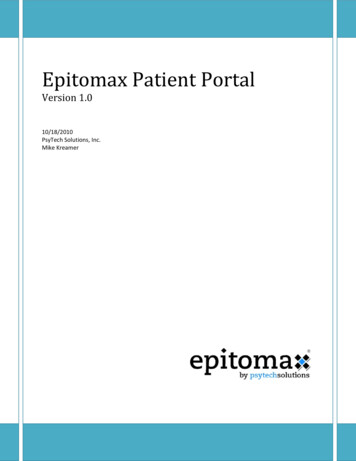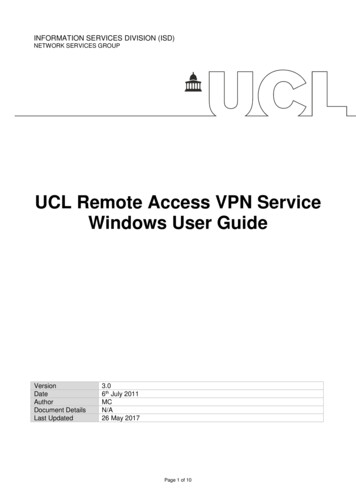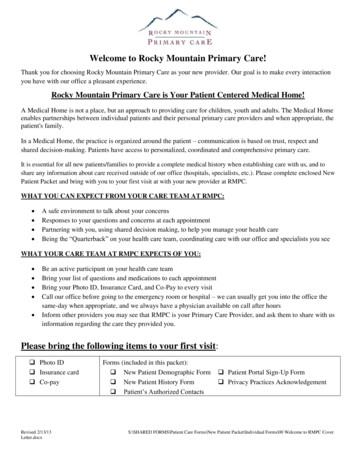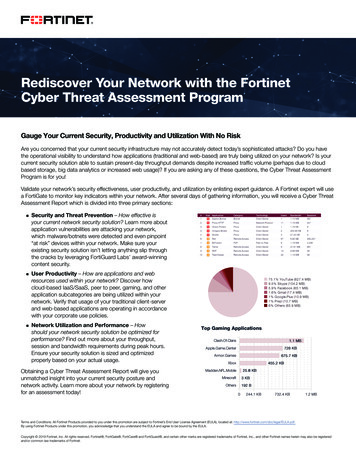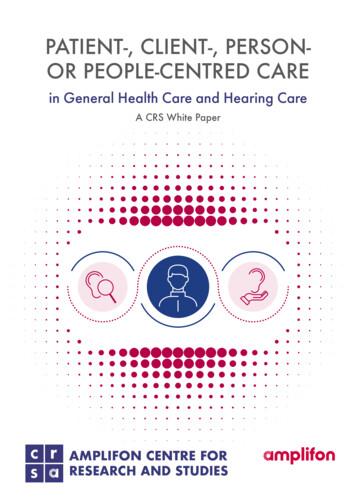
Transcription
PATIENT-, CLIENT-, PERSONOR PEOPLE-CENTRED CAREin General Health Care and Hearing CareA CRS White PaperCSrAMPLIFON CENTRE FORRESEARCH AND STUDIES
PATIENT-, CLIENT-, PERSON- OR PEOPLE-CENTRED CAREin General Health Care and Hearing CareA CRS White Paper - May 2022Mark LaureynsCRS – Amplifon Centre for Research & Studies – Milan – ItalyThomas MoreUniversity College – Department of Audiology – Antwerp - BelgiumAmplifon Centre for Research and Studies - Via G Ripamonti, 133 – 20141 Milan – Italy - www.crsamplifon.comIn the “World Report on Hearing” (ref 128), published by the World Health Organization on the March 3, 2021,the use of Person-Centred Care (PCC) is highly recommended.Putting the user in the driver seat and ensuring freedom of choice in the interest of the user are the fundamentalpillars of person-centred care (PCC), and they are reported to lead to higher satisfaction, increased use, and toresult in greater quality-of-life improvement with professional hearing care.This white paper discusses the history of Person-Centred Care, and offers a brief overview of existing studies andreports which focus on patient-, client-, person- or people-centred health care and hearing care.When searching for research papers, articles and other references on patient-centred care, we come across theterms client-centred, people-centred and person-centred care. Depending on the fact if it’s American or BritishEnglish, “centered” or “centred” is used. Please note that all citations are cited exactly in the original spelling,i.e. “centered” or “centred”.We carried out a search for research papers, articles and other references on patient-centred care. This wascomplemented by a duplicate search using the US spelling (“centered”). This highlighted the existence of multipleterms in relation to this concept: client-centred, people-centred and person-centred care. All of these were includedin our search (and will be discussed in this white paper). This yielded over 120 articles, reports and research theses.CONTENTS PageIntroduction. 2Patient-Centred Care: a historical overview. 3Patient-, Client-, Person- and People-centred health care. 5What can we learn from scholarly articles such as systematic reviews and meta-analyses,on patient-centred care? Have such publications demonstrated that patient- or person-centred healthcareleads to better results, higher satisfaction, or other outcome measures?. 5Which definition, aspects, and dimensions of patient- or person-centred healthcareare covered in these systematic reviews, publications and reports?. 710Patient-centred, Client-centred, Person-centred and People-centred hearing care. 12How much is patient- or person-centred healthcare used and do all patients/persons prefer it?.2
Historical overview of Patient-Centred careThe oldest known ethical code for health care practitioners is most likely the HippocraticOath (ref 11), of which the oldest fragment found dates back to the year A.D. 275. As wecan imagine, there are no references to patient-centred care in this Oath.The 1849 reprint of Percival’s book on medical ethics (ref 4) offers statements whichstand in stark contrast with Patient-Centred Care, such as: “The choice of a Physicianor Surgeon cannot be allowed to hospital patients, consistently with the regular andestablished succession of medical attendance.” One of the most striking statements isno doubt “No man censures a Physician for deceiving a patient too much dejected, byexpressing good hopes of him, or by denying that he gives him a proper medicine whichhe is foolishly prejudiced against : the patient afterwards will not reproach, him for it.” Percival’sposition and wording were used widely in the codes of conduct adopted by the American MedicalAssociation up to 1980.After nearly two centuries of the paternalistic “Beneficence Model” (ref 9), there was a gradual shifttowards the “Autonomy Model”, which, among other things, called for securing patient consent. Atthe beginning of the 20th century, the act of securing consent was mostly motivated by a desire toprevent or have evidence in the event of any medical malpractice claims (ref 9).In 1946, in “Significant Aspects of Client-Centered Therapy” (ref 5), Rogers introduces the term ClientCentred Practice in psychotherapy, which he claims to have been using in his practice since 1939. In alater publication in 1961 (ref 6), he states that, to that date, more than 40 studies had been publishedon this topic. Among other things, he introduced the notion of patient sovereignty: “The foundationof client-centered practice rests not on method but rather on the therapist’s respect for and personalopenness to the client as a sovereign being of inexhaustible depth and meaning.”After the Second World War, in 1947, the Nuremberg Code (ref 7) clearly declared that the “voluntaryconsent of the human subject is absolutely essential” in medical experiments.The first known reference of the term “informed consent” can be found in the “Salgo v. Leland StanfordJr. University Board of Trustees” court decision in 1957 (ref 12). The plaintiff, a patient named Mr Salgo,won a medical malpractice lawsuit, since neither he nor his family had been informed of the details andrisks associated with a medical procedure which ultimately resulted in Salgo’s permanent paralysis7.3
Years later, Kiresuk & Sherman (1968) designed the “Goal attainment scaling (GAS): A general methodfor evaluating comprehensive community mental health programs” (ref 2). Their framework relieson “Goal setting” with patients, taking their lifestyle, preferences and aspirations into account, all ofwhich offer an opportunity for deriving a patient-generated outcome.Example of a Goal Attainment Scale – GASAchievementGoal 1 2Much more than expected 1More than expected0Expected result-1Less than expected-2Much less than expectedGoal 2Goal 3Fig 1. Example of a GAS (Goals Attainment Scale)In 1973, the American Hospital Association published the Patient's Bill of Rights (ref 1), which statedthat “The patient has the right to receive from his physician information necessary to give informedconsent prior to the start of any procedure and/or treatment”.In 1977, Engel published “The need for a new medical model: a challenge for biomedicine” (ref 39).He introduces the “Biopsychosocial Model”, whereby health care providers are required to take a holisticapproach and focus on the whole person with a disease, as opposed to the traditional “BiomedicalModel”, where the key focus is the disease.At the end of the 1980s, there was a gradual shift among health care providers around the worldtowards a “New Public Management in Health Care” model, where the patient is seen as a consumerin search of the best care, and such metrics of personal autonomy, hospitality and patient satisfactionwere introduced (ref 40).4
Patient-, Client-, Personand People-centred health careAccording to the World Health Organisation, the term ”people-centred health care” should not beconfused with patient-centred health care. Indeed, the People-centred health care, is an “umbrella termwhich better encapsulates the foremost consideration of the patient across all levels of health systems”(ref 91). The latter, patient-centred care, would therefore be a subset within people-centred health.Wikipedia describes person-centred care in health care as when “patients actively participate in theirown medical treatment in close cooperation with the health professionals. Sometimes relatives arealso included in creating the health plan. The person-centred model of health care is used both for inand out-patients, emergency care, palliative care as well as in rehabilitation” (ref 86).The World Health Organization states that “Person-centred care addresses individuals’ health and socialcare needs rather than being driven by isolated health conditions or symptoms. A person-centred,integrated approach also embraces the context of individuals’ daily lives, including the impact oftheir health and needs on those close to them and in their communities” (ref 89).According to the International Alliance of Patients’ Organizations (IAPO) “Declaration on: PatientCentred Healthcare”(ref 47), “The essence of patient-centred healthcare is that the healthcare system isdesigned and delivered to address the healthcare needs and preferences of patients so that healthcareis appropriate and cost-effective. By promoting greater patient responsibility and optimal usage,patient-centred healthcare leads to improved health outcomes, quality of life and optimal value forhealthcare investment.”In addition to this overarching definition, IAPO provides an overview of the dimensions impacted bysuch a patient-centred healthcare approach: respect; choice and empowerment; patient involvement;access and support, and information.What can we learn from scholarly articles such as systematic reviews and metaanalyses, on patient-centred care? Have such publications demonstrated thatpatient- or person-centred healthcare leads to better results, higher satisfaction,or other outcome measures?Stewart (1995) ran a review on “Effective physician-patient communication andhealth outcomes” (ref 76) across 21 studies meeting the inclusion criteria: randomizedcontrolled trials and analytic studies of physician-patient communication with outcomeson patient health. She concluded that “Most of the studies reviewed demonstrated acorrelation between effective physician-patient communication and improved patient health outcomes”.Mead and Bower (2002) issued a review of previously published literature on “Patient-centredconsultations and outcomes in primary care” (ref 60). They came to a much more nuanced conclusion,stating that “although the current evidence base may be suggestive of a relationship between patientcentred consulting behaviour and patient outcomes, the case has not been made definitively, sincethe pattern of associations was not clear or consistent”. They also commented on the differencebetween their conclusions and the earlier study by Stewart (1995), explaining that this was due tothe difference in design and inclusion criteria, but mostly to the fact that the earlier review focusedon “general communication skills” and not on explicitly “patient-centred” behaviour.5
Griffin et al. (2004) carried out a systematic review of trials on the “Effect on health-related outcomesof interventions to alter the interaction between patients and practitioners” (ref 42). Based on the 35trials included, they somewhat cautiously conclude that “Successful interactions between patientsand their practitioners lie at the heart of medicine, yet there are few rigorous trials of well-specifiedinterventions to inform best practice. Trial evidence suggests that a range of approaches can achievechanges in this interaction, and some show promise in improving patients' health”. Highlighting theheterogeneity of study populations, design, settings and measures, with only one study explicitlylinking intervention through process to outcome measures, this study brought to light the need fora more rigorous approach in order to clearly establish positive correlations with health outcomes.Doyle et al. (2013) conducted “A systematic review of evidence on the links between patient experienceand clinical safety and effectiveness”(ref 37). Based on the 55 studies included in this review, theauthors concluded that “patient experience is positively associated with clinical effectiveness andpatient safety, and support the case for the inclusion of patient experience as one of the central pillarsof quality in healthcare”.Rathert et al. (2013) offered a systematic review on “Patient-Centeredd Care and Outcomes” (ref 69).Their literature review analysed a total of 40 articles, and they found “mixed relationships betweenPCC [Patient-Care] and clinical outcomes. Some studies found significant relationships betweenspecific elements of PCC and outcomes but others found no relationship”. The authors conclude thatthe two most-significant improvement variables achieved thanks to patient-centred care were patientsatisfaction and patient self-management.Kelley et al. (2014) studied “The influence of the patient-clinician relationship on healthcare outcomes”(ref 49). Through a systematic review and meta-analysis of randomised controlled trials. Based on 13randomised controlled studies on this topic they concluded that “the patient-clinician relationshiphad a significant positive (p 0,02) impact on the healthcare outcomes”.Barrio & Gual (2016) published a systematic review of randomised “Patient-centered care interventionsfor the management of alcohol use disorders” (ref 18). A total of 40 studies were included, reportingon more than 16,000 patients. They found that studies based on single sessions of motivationalinterviewing showed no clear benefit; studies based on multiple sessions of counselling showedmixed results, many showing the benefit of the patient-centred care (PCC) interventions. The mostpositive outcome was found in pharmacologically supported PCC interventions. The authors positthat “PCC-based interventions may be beneficial for reducing alcohol consumptionin people with alcohol use disorders”.Davis et al. (2020) conducted a systematic review on “The relationship betweenpatient-centered care and outcomes in specialist drug and alcohol treatment” (ref 33).They identified 25 articles on the topic, but only five articles had included patientcentred indicators other than satisfaction. Their results show that “although oftenof a small magnitude, the existence of significant positive relationships betweenindicators of patient centered care and improved outcomes was largely consistent”.To conclude on existing systematic reviews on patient-centred care, the more recent publicationsshow cautious yet positive conclusions. They do however show the need for further research, andthat moving forward, a more precise definition of the scope of patient-centred care is needed, aswell as more studies with a quality design.6
Which definition, aspects, and dimensions of patient- or person-centred healthcare are covered inthese systematic reviews, publications and reports?Mead & Bower (2000) carried out a review of existing empirical literature on “Patient-centeredness”(ref 59), and developed a conceptual framework based on the five main dimensions they identified:1. biopsychosocial perspective (much wider than only the medical aspects)2. patient-as-person (the person in the unique context)3. sharing power and responsibility (ensure greater patient involvement)4. therapeutic alliance (develop the emotional context in healthcare)5. doctor-as-person (self-awareness of emotional reactions and subjectivity)They state that since there is some inconsistency in the findings, specifically when related to thepatient’s health status and satisfaction, further research is needed.In a report titled “Improving Care for Older People. A Policy for Health Services” (ref 82), The AustralianVictorian Government Department of Human Services (2003) defined person-centred care as ”treatmentand care provided by health services [that] places the person at the centre of their own care andconsiders the needs of the older person’s carers”.The Australian National Ageing Research Institute (ref 62) produced a 111 page literature reviewtitled “What is person-centred health care?” (2006). This review was commissioned by the AustralianVictorian Department of Human Services, as part of an overarching strategy for Improving care forolder people. They identified the following principles of person-centred care, which are all driven bythe idea of partnership:1. getting to know the patient or client as a person2. sharing of power and responsibility3. accessibility and flexibility4. coordination and integration5. having an environment that is conducive to person-centred careHughes et al. (2008), in “Types of centredness in health care: themes and concepts” (ref 46), conducteda literature review on client-, family-, patient-, person- and relationship- centred care. They concludethat “Different types of centredness are required in different contexts. The differences are justifiedby their practical utility. The unifying themes of centredness, however, reflect a movement in favourof increasing the social, psychological, cultural and ethical sensitivity of our human encounters”.Pelzang (2010) published a literature review on “Time to learn: understanding patient-centred care”(ref 68). The author identified seven dimensions of patient-centred care:1) Respect for patients’ values, preferences and expressed needs (accept patient as person, involvepatients, listen and value patient needs, respect confidentiality)2) Coordination and integration of care (multidisciplinary, wide scope of care, involve patient and family)3) Information, communication and education (accurate and understandable information, active listeningto patient and family, provide therapeutic advice)4) Physical comfort (promote quality environment, manage symptoms and support normal body functions)5) Emotional support and alleviation of fear and anxiety (listen with full attention, provide qualityinformation and care with empathy)6) Involvement of family and friends (provide information, respect their support in care)7) Transition and continuity of care (discharge planning, clear information and education, referringappropriately)In addition to outlining the dimensions of patient-centred care, they list the knowledge and skills requiredfor implementing such an approach:7
Knowledge: Clinical practice Principles of practice Clinical problems (disease conditions)Skills: Data gathering or patient assessment skills Procedural skills (Including attention to patient comfort and dignity) Communication skills (Ability to communicate with patient, familyand professionals, including attentive listening) Relationship skills (Ability to develop and maintain the helping or professional relationship, includingempathy, mutual respect and joint participation) Reporting and recording skills (Ability to maintain and communicate the details of patient clearly,completely and concisely)They conclude with the following key points: Patient-centred care places the patient at the centre of the healthcare system It considers the patient as a whole person with physical, psychological and social needs The provision of a supportive environment that promotes recovery is recognised as a critical role of thehealthcare profession, and health professionals need to have the skills to provide supportive, holistic care Implementation of PCC requires adequate and appropriate education on PCC, with a planned andcoordinated approachThe Australian Commission on Safety and Quality in Healthcare published a very comprehensive 104page report (ref 16) titled “Patient centred care: Improving quality and safety through partnershipswith patients and consumers” (2011). The report states that “Patient-centred care is health care thatis respectful of, and responsive to, the preferences, needs and values of patients and consumers. Thewidely accepted dimensions of patient-centred care are respect, emotional support, physical comfort,information and communication, continuity and transition, care coordination, involvement of familyand carers, and access to care.”This comprehensive report covers a wide range of topics:1. What is patient-centred care?2. Drivers, approaches and initiatives for patient-centred care3. The relevance of patient-centred care to the Australian health system4. Current jurisdictional and other activities in Australia5. Making progress on patient-centred care in AustraliaVahdat et al. (2014) conducted a review on “Patient Involvement in Health Care Decision Making” (ref 80).Of the original 100 articles and five books included in the study, only 30 articles and two books met theinclusion criteria after further screening. Based on their findings, they were able to identify six relevantcategories:1. definition of participation,2. importance of patient participation,3. factors influencing participation of patients in healthcare decisions,4. method of patient participation,5. tools for evaluating participation, and6. benefits and consequences of patient participation in health care decision-makingIn 2016 the UK Royal College of Physicians published a special issue of the “Future Health Journal” on“Person Centred Care” (ref 44) covering a range of themes:8
ealth coaching training for clinicians;H Legal, ethical and professional considerations for Person-Centred Care; How such approaches apply to long-term conditions; Personal experiences of practitioners.In particular, the report highlights the challenges of expanding such an approach in a system underconsiderable stress, and the need for a two-fold approach: identifying patients’ health goals andexpectations in times of healthcare service provision.Santana et al. (2018) produced a narrative review of the person-centred care (PCC) literature, for theirarticle: “How to practice person-centred care: A conceptual framework” (ref 70). Based on their review,they developed a very clear and structured framework. Overall, they identified the three different levelsof person-centred care: structural (healthcare system and organization); process (patient & healthcareprovider); and outcome (patient, health care provider and healthcare system). For each of these levels,they further identified a number of domains.Structural level:1. Creating a PCC culture (core values, philosophy and defining PCC);2. Co-designing the development and implementation of educational programs (a standardized PCCtraining) ;3. Co-designing the development and implementation of health promotion and prevention programs(empowering patients and organisations in the development of the program) ;4. Supporting a workforce committed to PCC (ensure there are enough resources available) ;5. Providing a supportive and accommodating PCC environment (the health care facility and the servicesneed to be PCC designed and need to promote PCC) ;6. Developing and integrating structures to support health information technology (e-health platformfor health information exchange) ;7. Creating structures to measure and monitor PCC performance. (framework to measure, monitorand evaluate).Process level:1. Cultivating communication (listen to patients, share information and discuss care plans with patients);2. Respectful and compassionate care (responsive to preferences, needs and values);3. Engaging patients in managing their care (designing care plans);4. Integration of care (information sharing across the full care timeline).Outcome level:1. Access to care (timely access, availability, financial access);2. Patient reported outcomes (outcome measures, experiences and adverse outcomes).Most systematic reviews on the topic cover the following five key dimensions of patientcentred care: sharing – patient involvement; patient as person; assessing patient needsand values; coordination, integration, environment, structures for PCC.Secondary dimensions include : biopsychosocial perspective and culture; emotional context;doctor as person; accessibility, information – communication.A range of other topics are addressed in a non-systematic way in these reviews and reports,such as: involving family and friends; transition and continuity of care; patient reportedoutcome; and lastly, education and training.See table 1 on page 15 for the overview.9
How much is patientor person-centred healthcare usedand do all patients/persons prefer it?Stewart (2001) wrote a very interesting editorial on “Towards a global definition of patient centredcare. The patient should be the judge of patient centred care” (ref 78). He states that not every patientprefers a person-centred approach, and it may even be counter-productive or unwise in some cases.He argues that, in fact, patient-centred means that professionals should take an individualisedapproach in order to take into account the patient’s preference for information and for their desiredlevel of shared decision-making.In 2006, Langewitz et al. conducted a survey on “Hospital patients' preferences for involvement indecision-making” (ref 52), on 1,040 patients from a Swiss university hospital. The researchers foundthat 79% of respondents agreed that “One should stick to the physician's advice even if one is notfully convinced of his ideas”; 66% agreed that “It should completely be left to physicians to decideon a patient's treatment”; and 96% agreed that “Even when the news is bad the patient must beinformed”. This survey demonstrates that not all patients prefer shared decision-making in healthcare,but also that honest information if essential.In 2007, Bastiaens et al. published a study on “Older people’s preferences for involvement in theirown care: A qualitative study in primary health care in 11 European countries” (ref 19). The authorsinterviewed 460 primary care patients aged between 70 and 96. They conclude that people over 70 dowant to be involved in their care but their definition of involvement is more focussed on the “caringrelationship”, “person-centred approach” and “receiving information” than on “active participationin decision-making”. Given the diversity of responses, the main takeaway is that patient involvementneeds to be individualised, particularly so for the older age groups.The WHO-European Office report (2013) “Towards people-centred health systems: An innovativeapproach for better health outcomes” (ref 89), states that “To accelerate gain in health outcomes andreduce health inequalities, health systems must be financially viable, fit for purpose, people-centredand evidence-informed.” The report also highlights the extent to which shortcomings and structuralweaknesses of certain European health systems hinder the development of an inclusive, evidenceinformed and people-centred approach which covers the entire life span. Moreover, it stresses thatthe lack of systematic quality improvement schemes across the European region for service delivery,results in care that is not always evidence informed and rarely patient centred.In 2016, the Care Quality Commission (CQC) in the UK published a report on ”Better care in my hands.A review of how people are involved in their care” (ref 32). The report assesses the level and qualityof people’s involvement in their health and social care, based on the evidence from CQC’s nationalreports and inspection findings, national patient surveys and a literature review.10
The report offered interesting insights, categorised into types of care: Acute care: to the question “Were you involved as much as you wanted to be in decisions aboutyour care and treatment?”, 57% responded “yes”; 34% responded “yes, to some extent”; and 10%responded “no” (2014 survey). The report also offers the breakdown of survey responses from2005 till 2014, showing this to be very stable over the years. Mental health care: to the question “Were you involved as much as you wanted to be in agreeingwith what care you will receive?”, 56% patients responded “yes”; 37% responded “yes, to someextent”; and 7% responded “no” (2015 survey). The report also offers the breakdown of surveyresponses 2010 till 2014, with very stable results over the years. Primary Care (General Practitioner – GP): to the question “How good was that GP at involving you indecisions about your care?” 39% responded “very good”; 35% responded “good”; 13% responded“neither good nor poor”; 3% responded “poor”; 1% “very poor”; and lastly 9% responded “doesn’tapply” (2016 GP survey). The report also offers the breakdown of survey responses from 2005 till2014, with very stable results over the years. Adult Social Care (Personal Social Services Adult Social Care Survey 2014/15): for this particularcategory, the results were less positive. To the question “How much control do you have overyour daily life?” 33% responded “as much as I wanted”; 44% responded “adequate control”; 18%responded “some control, but not enough”; and 5% responded “no control”. The report also offersthe breakdown of survey responses from 2010 till 2014, with very stable results over the years.The final recommendation of the report stresses the need for: “providers and commissioners ofservices, and voluntary sector organisations to work together to ensure that health and care servicesconsistently involve people throughout their care, and that staff are supported to communicate withand support people and their families to be involved in their care in the ways they wish.”Turner & Archer (2020) published “Patient-centred care: The patients’ perspective – A mixed-methodspilot study” (ref 79), a study conducted in South Africa. Including articles which are from other regionsof the world can shed a different light on the regional/cultural differences in patients’ perspectives.The responses the authors collected from a survey conducted among 120 people offer interestingresponses on statements related to empathy: “The doctor tries to make me feel comfortable”: 7% not important; 8%, neu
Amplifon Centre for Research and Studies - Via G Ripamonti, 133 - 20141 Milan - Italy - www.crsamplifon.com . reports which focus on patient-, client-, person- or people-centred health care and hearing care. When searching for research papers, articles and other references on patient-centred care, we come across the .
